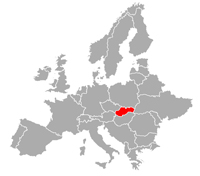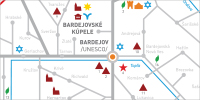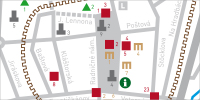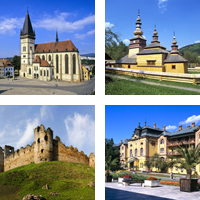|
   
|
The excellence of Bardejov’s medieval crafts was one of the principal reasons for the town’s economic rise. Skilled artisans, clever tradesmen and royal privileges helped Bardejov to reach its apex of glory and wealth during the fifteenth century.
The most important craft in medieval Bardejov was weaving. Weavers, in comparison to other craftsmen, had a larger quantity of products and a superior organization. The trade was probably inherited from the indigenous Slavic population, later influenced by German colonists from Silesia who had a great tradition of weaving.
A document dated to 1551 sheds light on local wood and metal-working crafts. It points out that the Bardejov’s artisans worked on 30 light corvettes (light warships). Although the town did not usually produce warships, local masters were guided by two outside specialists on their quest to manufacture such unusual products. The work was done in less than four months with the actual construction work preceded by the search for and processing of adequate wood.
Other prominent craftsmen of period Bardejov include the tailors, the shoemakers, the brewers, the furriers, hatters as well as glassworkers. According to archival sources from 1437 Bardejov had 64 crafts and 146 masters. In terms of today’s territory of Slovakia such a number was only present in Bratislava, Košice and Levoča.
Many period crafts existed within the framework of a guild organization. During feudalism Bardejov had an extraordinary number of guilds amounting to 51 in total. Some of them began already in the middle ages. A larger number of guilds were present only among the principal towns of kingdom of Hungary such as Bratislava and Košice. For comparison, in the Polish town of Cracow of fifteenth century, there were 30 guilds. It’s the town’s guilds that gave Bardejov its most precious treasures – 11 gothic altars, located in the Basilica of Saint Egidius. Every altar was financed and taken care of by a wealthy guild.
|
The famous Weavers’ Guild of Bardejov was set up already in the first half of the fifteenth century. The first mention of a textile industry in the town comes from 1407. In 1429 king Sigismund of Luxembourg gave Bardejov a royal privilege (monopoly) for bleaching of linen. At a later date the guild masters in cooperation with the town council created regulations. Any local could become a weaver. The finished linen, however, could be only sold to the town. The burgers also supervised the quality of the fabric which was further transported to a bleachery. This process was the first manufactory in the kingdom of Hungary. The town of Prešov led a long lasting feud with Bardejov since 1446 regarding the right for bleaching of linen. The case was forwarded to the king Matthias Corvinus, who in 1480 forbade Prešov to conduct this activity with a fine of 4000 florens. The linen of Bardejov made the town rich and the product was sold all over the kingdom of Hungary.
The first half of the fifteenth century saw the creation of the Brewers’ Guild. The beer is commonly included in the town’s registry as a gift with which the locals gave respect to important people. In 1426 the burghers of Bardejov have sent a barrel of beer to the famous Polish knight Zawisza Czarny. The bishop Péter Rozgonyi received a barrel of wheat beer on the same year. Another barrel went to the wife of the master of the treasury a year later. In 1440 the burgher’s gave a barrel to the aldermen of Košice as a gift. The Polish family of Balicki, who ruled over Bardejov for almost the whole of the fifteenth century, received beer regularly. Even the construction workers received a pint for refreshment. It must be said however that the medieval beer was different from the modern one. The older beer had a denser quality and lower percentage of alcohol. The Brewers’ Guild reached its peak in the seventeenth and eighteenth century. At that time it had most members in its existence and was among the most prosperous.
The early fifteenth century marks the beginning of the Tailors’ Guild. The first reference about the guild dates to1435. The Furriers are first mentioned in 1457. From 1475 comes a reference about the Guild of Potters (the very first within the territory of present day Slovakia). The oldest reference to a Coopers’ Guild comes from 1478. Two years later the sources confirm the existence of a Carpenters’ Guild. In 1492 the Girdlers’ Guild makes an appearance. A document from late fifteenth century mentions locksmiths and an Armorers’ Guilds. In 1494 one can also assume the existence of a Smiths’ Guild.
|
The Shoemakers’ Guild left regulations dated to 1499 which among other things included the conditions necessary for a journeyman to become a master. The raw leather had to be first processed and then 3 pair of shoes were be made out the material by an apprentice. One pair of shoes was manufactured according to the newest fashions, the remaining two after more common norms. The regulations forbade the guild members to select their own apprentices and journeymen.
An early sixteenth century document, containing the necessary quota of fighting men for city defense, also mentions a Butchers’ Guild, masons, broadcloth makers and fishermen. The sixteenth guilds mentioned so far by the sources are however far from the alleged fifty one. Other guilds were probably created at a later period. Their increased number occurred despite the fact that the town was beginning to fade economically after the middle of the sixteenth century. Some professions did not have a guild – among these were the goldsmiths, the iron-founders, spa workers, bakers, millers, painters and last but not least the doctors.
The guilds played an important part during the development of craftsmanship. Their rigid rules however retarded further development until their abolishment. In 1872 the guild system officially ended. An impressive collection of objects belonging to Bardejov’s guilds (coat of arms, chests, documents, bottles, seals and goods) is on display at the historical exhibition of Šariš Museum in the historical building of the town hall.
The fact that a Funeral Guild still exist in the nearby village of Kurima seems incredible. The guild was first set up in 1690 and prepares the office of the dead until today. The members call themselves brothers and commute every year on the day of epiphany. Their meetings start with a prayer. A sample of the prayer reads: “Saint Anthony, you are the patron of our brotherhood, established centuries ago by our honorable forefathers. Your aid is immeasurably strong. You have helped us again this year while we conducted the last services and prayers for our deceased brothers and sisters, which preceded us into the afterlife. At the same time we have soothed the bereaved relatives.”
Translated by:
Mgr. Samuel Beňa, M.A.
|

















